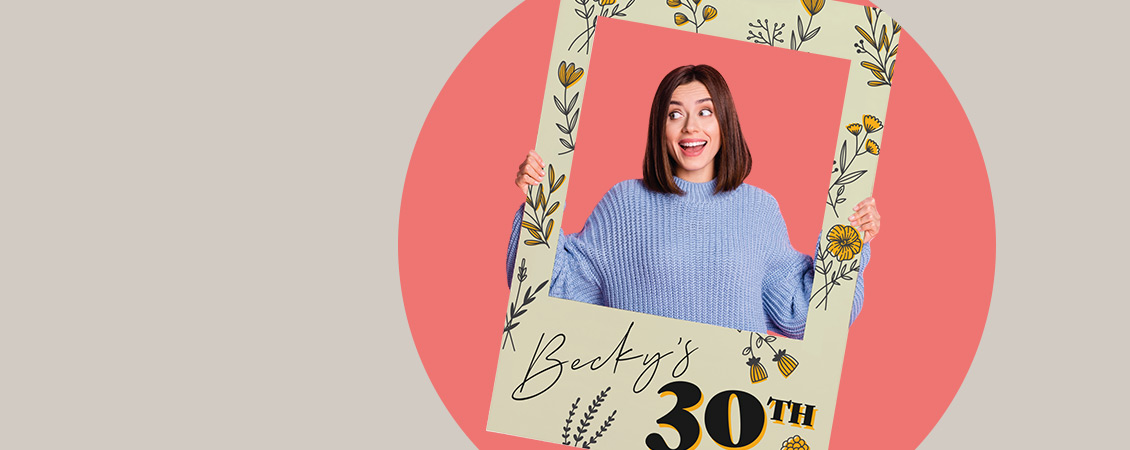Update: 17th May 2023
Gradients are a smart way to spruce up your designs, but can be tricky to get right. Too little and you may as well not bother, too much and it can be distracting from the overall finish. A retro 90s trend that’s been gaining traction over the past couple of years, gradients are being used in designs for all kinds of businesses.
In this blog, we’ll answer all your FAQs about gradients, including what they are, how to make one, the best ways to use them in graphic design and some real-world examples of gradients done right.
What is a Gradient?
A gradient is, essentially, a fade from one colour to another. It can be from black to white, grey to darker grey, red to pink…and it isn’t limited to two colours, either! It’s all about how many dots of ink are printed in an area. A gradient is designed to have lots of dots at the start of the gradient, which then fades out to fewer and fewer dots, spaced further apart, until the end of the fade.

A gradient can move from one colour to any other (or several!), or, like this one, from one shade to another.
Why Should I Use Gradients?
A gradient can give depth and texture to an image background. They should be used sparingly, however, as too harsh a gradient or too many can detract from the overall image and overpower the artwork.
Gradients give the impression of light and shade, and even movement if used well. They’re great for drawing attention to some text, or can be used on an image to fade it out to a white background.
In recent times, gradients are being chosen as backgrounds for web landing pages in particular as opposed to block colour backgrounds because they create interest and fluidity. The rest of the page is then simplified as not to be too overwhelming. For example, the Startuply landing page below uses a gorgeous orange to purple gradient overlay on top of a city skyline, but the rest of the page is really minimal.

Real Examples of Brands Using Gradients in Their Designs
Instagram
Gradients really started hitting the scene again back in 2018, when photo-sharing social media platform Instagram refreshed its logo to include a bright yellow to purple gradient.

Spotify
If you’re a Spotify user, you’ll know that gradients are one of the key features of the brand, featuring on artist profiles and more.

Chilly’s
Proving that gradients aren’t just for logos and web design, Chilly’s water bottles boss this trend! We’d love to take a drink from one of these two-tone bottles.

How to Choose Your Gradient Colours
Depending on the look you want to achieve, there are really no rules to the colours you can use to create a gradient. They can be similar colours for a subtle finish or could even blend contrasting colours. You can use multiple colours, or different shades of the same colour – seriously, anything goes!
However, to create a smooth blend, it’s a good idea to pick an in-between colour; otherwise, you might be left with a mushy, grey middle area in your design (a look we’re hoping to keep in the 90s!). To do this, simply pick a middle colour in your gradient’s spectrum.
The best way to choose your gradient colours is to try a few out! If you’re stuck, think about real-life gradients found in nature, such as sunsets and sunrises, or multi-coloured petals on flowers.
Check Your Spectrum: RGB Or CMYK?
You’ll most commonly see gradients on your computer screen, as they translate very well to an RGB spectrum.
An RGB palette contains many more colours than a CMYK one. This means gradients can appear smoother in comparison, and is why you’ll see gradients used in digital media most frequently.
During the printing process, dots of ink are layered to create the desired colour. Using an RGB spectrum to print can significantly change the standard quality across a print run, especially if more than one press is used. This is why most commercial printers will use the CMYK spectrum, as the colours can be standardised and a high quality guaranteed.
As CMYK is what most commercial printers will use to print your project, it’s worth making sure that your design software is set up to create artwork in CMYK. This saves you time on converting the project later on, and avoids potential pitfalls of the post-artwork conversion from RGB to CMYK (which isn’t even always possible to do!).
A gradient using a CMYK palette can take some skill to get right. The more limited range of colours available on the CMYK spectrum can make a colour progression less smooth. The way ink is printed, in a multitude of dots to build the image, means that poorly-devised gradients can turn out looking patchy, pixelated, or otherwise inconsistent. Don’t let that put you off though! It just takes a bit of practice (or a professional designer) to make sure you get a smooth fade on your printed design.
How To Make Your Printed Gradient Look Awesome
Gradients can be a great way to turn a dull, flat background into something more vivid, eye-catching, and textured for a printed document. If you can’t afford a designer for your artwork, or you want to boost your own skills, here are some top tips from the instantprint design studio to help you make the most of gradients for your printed project:
- You can usually locate the gradient function on design software with an icon that looks like a rectangle that fade from black to white
- Make sure your fade is suitably long (which makes it as smooth as possible), otherwise you could end up with a harsh line midway through the gradient on your finished product.
- Experiment with gradients either on one base colour to a variation of that colour (such as dark blue to light blue), or one colour to a very different colour (such as grey to pink) to see what works for your design.
- If you’re placing text over the gradient, put it on the most solid area (the start of the gradient) to make sure you don’t lose any clarity through the fade.
- Play around with different gradient lengths, angles, and positions to see what works best on your project page.
Try experimenting with gradients on images, too. If you’re creating a printed photography portfolio, for example, gradients can be used to add vignettes, frames, or fades to a background colour (such as the white page).
When printing out a copy of your design to check it ‘in real life’ before sending to print, remember that your office printer probably uses the RGB spectrum to print. This means, if your design software is set up in CMYK, the colours may not look completely right. The good news is that you can check the CMYK colours on a computer monitor that has been calibrated to view CMYK colours.





